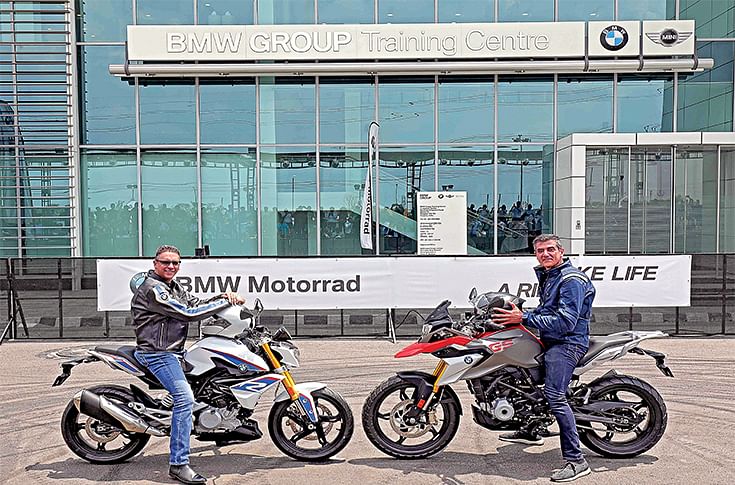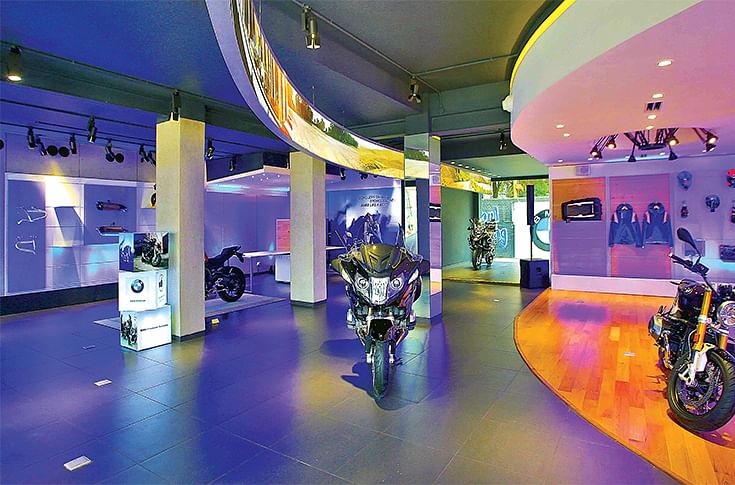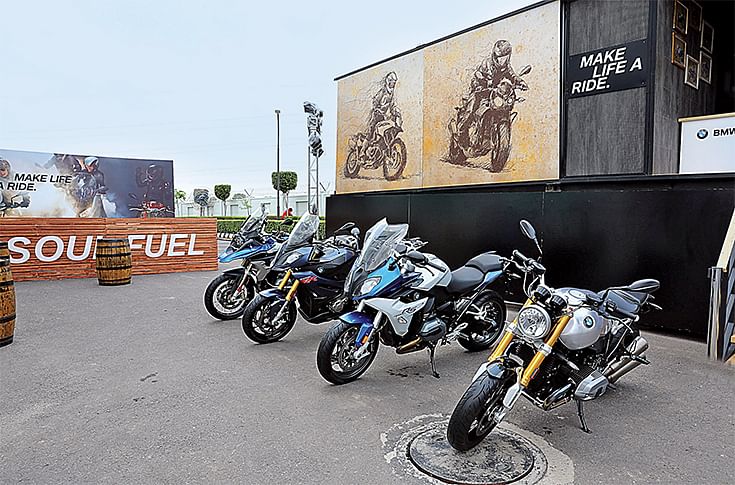Dimitris Raptis: ‘Our tie-up with TVS Motor Co for the 310s was a very good decision.’
BMW Motorrad’s Head of Region Asia, China, Pacific and South Africa on the importance of the 310s in the company's 2020 sales target.
BMW Motorrad’s Head of Region Asia, China, Pacific and South Africa speaks to Autocar Professional on the made-in-Hosur G310R and G310GS, the importance of the 310s in the company's 2020 sales target, India's growing midsize motorcycle market and achieving sustainable growth.
BMW Motorrad has just launched its most affordable bikes in India – G310R and G310GS. It has been selling them in Europe and USA for a few months now. Isn’t the 2020 target of achieving global sales of 200,000 units too conservative, given that BMW’s two-wheeler sales in CY2017 were at about 164,000 units?
The volumes that we are expecting from the 310s (G310R and G310GS) are already included in the target of 200,000 units (by 2020). So far the performance (sales in markets where the 310s are already launched) is according to our plan. We are pretty sure that the role of the 310s is well established in setting up this (sales) target. The addition of India makes us more confident that, what we are planning for the 310s will be achieved by 2020. India is the last market where we launched these bikes.
How important is the India market for BMW Motorrad now and in the mid-term?
I think India can be a very big surprise that we might need to revise our planning here. But that will depend upon how the 310s will be accepted in this market. So far the first signs, although it is too early to say this, are very positive. From the bookings we have for the 310s, the demand appears to be high. But we cannot be 100 percent sure about the volumes at this point in time. We need to spend a year to see how it develops and then we will plan the next years accordingly.

Vikram Pawah, president, BMW Group India, and BMW Motorrad's Dimitris Raptis at the launch of the G310R and G310GS in Delhi-NCR on July 18.
About a year-and-a-half ago, India was a very small part of global sales for BMW Motorrad. Once we started the local operations, in April 2017, we started selling the first CBU (completely built units imported into India) bikes. Of course, the import tax here is high and is part of the price. But nevertheless, we tried to adapt our pricing here in India. I believe that the acceptance for the CBU bikes is quite good. I would say we are moving as per our plans. Let’s see how the future develops for us.
BMW is one of the most desirable automotive brands in India. Is there any annual sales target that you have set for the 310s in India?
It would be too early to think about what would be the right target for next year. My personal feeling as I said from the first signs is that the order bookings are very positive. But for now, I want to see how the year will end. We have a good portion of the production (of the G310R and G310GS) allocated to India. My feeling is that the demand (in India) will be a bit higher than what we have planned. So we will have to wait and see. The bikes (310s) have not even been delivered to the customers yet (as on July 18). It is too early to comment.
How many markets are the G310R and G310GS currently exported to from India?
Worldwide! The 310s are exported to all of our markets. There is no single market where we are not exporting the G310R and G310GS. This project was made for the global markets and not only for India. We are very happy with the performance so far.
How do you define the evolving midsize motorcycle market, which is further categorised in 250cc-500cc and 500cc-800cc segments, in India?
I think it is a very interesting segment for India. There are a lot of people commuting on two-wheelers and a majority of them ride entry-level or 125cc or smaller vehicles. The midsize motorcycle segment accounts for a very small percent of the overall market. However, even this small percentage of the overall market is a huge number and represents the potential customers in the middleweight motorcycle category (250cc-500cc). I think this is an exclusive characteristic of the Indian two-wheeler market as you don’t find this in other global markets so much.
So the products that we have launched will play in the high-growth category (250cc-500cc bikes) in India. I feel we have a very good price positioning. We are confident about the product as it offers a good combination of fuel consumption, agility, riding characteristics, engine performance, quality – all these together, I think, the competition cannot match.
This confidence is growing because of the feedback that we are getting from the customers from mature motorcycle markets such as Germany, USA, Japan and others. They are not buying the bike because it is an entry-level BMW Motorrad but because it is the bike (G310R and G310GS) that they want to have. This is the biggest confirmation for us that we have taken the right step.

BMW Motorrad India, which had five dealerships as of December 2017, plans to have seven by end-August 2018, and 10 by March 2019
Of course, you have to be competitive in this segment and you cannot be out-priced, and that was one of the reasons why we opted for the cooperation with TVS Motor Company. I think that was a very good decision because so far we have had an excellent cooperation and the philosophies of the two companies match.
Are the BMW 310s being sold in China? If so, how are they faring?
Yes, they are up for sale in China too. It is a big part of sales in China. I think it will be a big part of the future volumes in China as per the plan.
While BMW Motorrad has forayed into the entry-level midsize category with street and adventure formats, is it likely that the company may look at other motorcycle formats too?
First of all, the product cycle is a long one. The products that will come in the next years have already been decided a long time ago. For the moment, in this segment we have not made any decision to go lower or higher than the 310. But having said that, we have many ideas and many discussions are taking place currently in BMW Motorrad.
The company sold 252 CBU bikes between April to December 2017. It has already sold 248 units in the first six months of CY2018. This number will exponentially grow with the launch of the G310s.
But we don’t have anything concrete to announce. We will see how the interest around these motorcycles will generate over time. But for the moment, we are clear which products will help us achieve our target of 200,000 units by 2020. I can say that the 310s are a significant part of this number.
Across all the regions that you are responsible for, which markets look most promising to you?
At the moment, the biggest market is China (for the entire BMW Motorrad portfolio). It is a new market, it is an emerging market (for us) and the motorcycle industry there is big. The problem with China is that in most of the cities you are not allowed to ride a combustion engine-driven motorcycle. Instead they allow the cheap (affordable) electric scooters. That said, China is a market with big potential.
In India, on the contrary, motorcycles are allowed everywhere. So that is a strong argument in its case. However, the market demand is largely for bikes smaller than 500cc. In China, they have a market for bigger bikes too (bigger than 500cc).

The G310R is expected to sell more than G310GS in India
Japan is one of the biggest motorcycle markets in the world for us. Specifically, Japan is the biggest market for bikes bigger than 500cc in Asia. However, the competition there is very strong. I see that in the coming years India has the potential to become a Japan-like market.
Are you not keen on ASEAN markets? How is the response to the 310s from there?
Yes, of course! Thailand is a strong market for the 310s. The 310s are on sale in Thailand and the response is good. But also it is very competitive market in terms of pricing because you have a lot of local manufacturing there. Many Japanese motorcycle manufacturers produce bikes locally in Thailand and they have an advantage.
Can you share the total production capacity for the BMW 310cc bikes under the arrangement with TVS Motor? Industry data suggests that BMW Motorrad’s Indian partner produced an average of 2,000 units per month, and that more than 25,000 units were exported from India last year (FY2017-18).
This is the number that we have accounted in our planning so far. Until now we have taken no decision on increasing that number. This was the plan from the start and we are going with it for the moment. But you know plans are meant to be revised depending upon the market conditions.
We are focused on achieving sustainable growth. We don’t want to make fireworks and then disappear from the market. We want to have a long-term relationship with our customers. Customer satisfaction is really important for us. So we don’t want to make decisions only looking at the volumes. The idea of sustainable growth should not only work for us but also work for our dealer partners, who are basic ingredients of the whole ecosystem. We don’t want to grow volumes without growing the dealer footprint or vice-versa. These things have to go hand-in-hand. Otherwise, we jeopardise our long-term business in the market and, as I said, India can be a very significant market for my region and worldwide for BMW Motorrad.
Are you also looking at business via accessories and merchandise around the BMW Motorrad brand in India?
Definitely! BMW Motorrad is one of the few manufacturers who offer so many additional businesses together with the motorcycles. We offer riding gear collection, accessories, lifestyle products and our services. The model that we have already coming from the bigger bikes is something we would like to have for the 310s. Of course that cannot be done overnight. Rather, we will start with limited collection of riding gear and accessories for motorcycles. I think India is definitely the right platform to extend our product offerings. So we have plans but it will some time. We need to see demand for these from our customers and also what competition is offering.
(This interview was first published in the 1 August 2018 issue of Autocar Professional)
RELATED ARTICLES
India: A Bastion Of Stability for Schaeffler
German autoparts maker Schaeffler’s CEO, Klaus Rosenfeld, describes India’s role in the company’s €24-25 billion empire....
'No Question of Us Being Late' - Suzuki India on e-2Wheeler Market
Suzuki Motorcycle India believes its EV entry is timely as the market is now mature enough to grow off genuine demand ra...
'India Can Become a Major Pillar for Us' - Marquardt Group
Björn Twiehaus, CEO of Marquardt Group, and Vishal Narvekar, the company's India GM, share their outlook on the Indian m...





 13 Oct 2018
13 Oct 2018
 25017 Views
25017 Views






 Ketan Thakkar
Ketan Thakkar


 Angitha Suresh
Angitha Suresh

 Darshan Nakhwa
Darshan Nakhwa

